
"Red Bull" - a new variety of red pepper, which combines high productivity, ease of cultivation and early maturity. As you know, pepper is a thermophilic plant, so the “Red Bull” is best grown in greenhouses or on window sills at home. Given the harsh Russian climate, most gardeners only grow red pepper seedlings.
The bush of the plant can reach a height of 150 cm. The “Red Bull” pepper gives such a rich harvest that the stem of the bush can fall and break under the weight of the fruits, so they should be tied. The fruits of the “Red Bull” are really huge - they can reach a length of 15-30 cm and a width of 9-12 cm! The average weight of the fetus is 250-400 years. The peel of the fruit is thick (up to 1 cm). The color of the fruit at the ripening stage varies from light green to dark green, and during full ripening the fruit has a bright red color. The fruits are juicy and sweet.
Content
Growing
Experienced gardeners know that pepper is a short-day plant, that is, the shorter the daylight hours, the larger and tastier the fruits. The Red Bull is no exception. In addition, he does not need bright lighting, which is his huge advantage when grown in greenhouses.
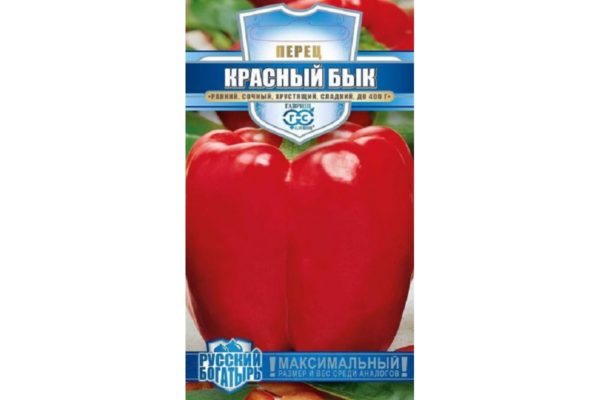
Requirements that are put forward to the soil on which pepper will grow:
- neutral reaction of the medium;
- the absence of nitrogen ions (in the presence of nitrogenous substances, the plant will become poorly tied flowers and, accordingly, give less fruit);
- friability;
- humidity;
- optimal amount of nutrients;
- absence of larvae of pests and pathogenic microorganisms.
In order for the seeds to grow faster, the soil for seedlings is prepared as follows. It is necessary to take in equal proportions land from the garden and manure (or other natural fertilizers, which include nutrients necessary for the development of pepper). It is better if the land is taken from those plots where other representatives of the Paslyonov family had not previously grown (for example, potatoes, tomatoes, eggplant, etc.).
Note! During the purchase of the seeds of the “Red Bull” on the packaging you will find a postscript after the name - “F1”. This means that this species is a hybrid. This does not affect the taste and benefits of the product, but hybrids cannot be harvested, that is, new plants cannot be grown from the seeds of hybrids. Such “descendants” may have poor presentation and poor taste.
How to improve the crop
In order to protect the crop from certain diseases, as well as increase productivity, follow these rules:
- Before planting seeds in the soil, they should be sprinkled with a 2% solution of potassium permanganate, which is endowed with bactericidal properties. This procedure allows you to protect plants from viral and fungal infections. The solution should be warm. Rinse the seeds with cold water after irrigation.
- In order for the seeds to germinate faster, they must be put in a damp handkerchief moistened with a heated nutrient solution and stored in a plastic bag where the seeds will dry.
- Seedlings are best kept at room temperature (22-240C).
Sowing seeds for seedlings is best between late February and early March. Seeds for seedlings germinate on the fifth - seventh day.
Dive into separate pots should be no earlier than the appearance of 1-2 real leaves. After the seedlings are transplanted into the open ground, the side shoots and leaves should be removed, and the bush itself tied up.
Seedlings should be planted to a depth of 2-4 cm (about half a finger in depth) with a distance between the seedlings of 20-40 cm.
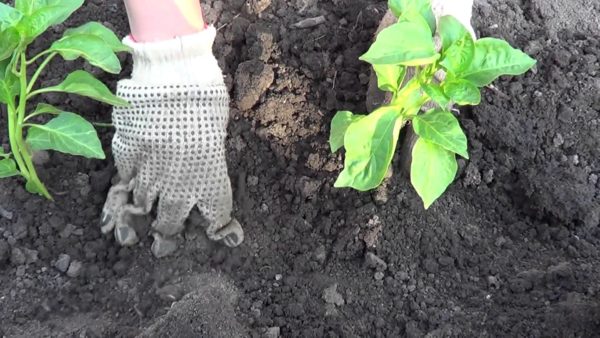
Advice! The "Red Bull", as mentioned above, gives a very large crop: 7-9 kg of fruit per square meter of land. Given this fact, it is recommended to collect the fruits at the ripening stage, when they have already acquired the final shape and size, but still have a light green color. Do not worry! The fruits of the "Red Bull" are stored for a long period and will be able to ripen at home - on the windowsill or near the window. In this case, it is important that the pepper receives a sufficient amount of light.
Advantages and disadvantages
So, now let's summarize all the pros and cons of the Red Bull pepper.
Benefits:
- rapid ripening of fruits;
- the fruits are fleshy, juicy, large and sweet;
- the variety is easy to grow (does not need bright lighting and a long daylight; there is no need for the introduction of mineral fertilizers, etc.);
- resistant to most nightshade diseases.
Disadvantages:
- Needs a garter
- grown only in seedlings;
- requires high soil purity.
Useful qualities and a place in the medical industry
As a result of research, scientists came to the conclusion that the composition of the Red Bull pepper includes such substances useful for the human body as:
- most B vitamins (thiamine, folic acid, etc.);
- ascorbic acid (vitamin C);
- carotene (provitamin; when interacting with fats, it turns into vitamin A);
- essential oils;
- carbohydrates;
- nitrogenous substances;
- minerals: sodium, potassium, calcium, ferum, sulfur, silicon, phosphorus.
And also as a result of research, it was proved that carotene and vitamin C, which are part of the “Red Bull”, prevent the development of cancer cells and promote the healing of stomach ulcers.
Reviews
Christina from Voronezh planted the seeds of the “Red Bull” and shared with us such information that almost all the seeds came from. And although this is not an early ripe subspecies, the gardener managed to collect a rich harvest, which amounted to 8 kg per square meter.
Irina from Tolyatti:
“The fruits of the Red Bull variety are really very large and juicy. She recommends using them as a fortified product in fresh vegetable salads. ”
Svetlana from Moscow:
“The Red Bull pepper gives huge crops, which her family is not able to consume in one season, so the gardener stocks up tasty preservation for the winter. Svetlana complains that the fruits are too large and she has to cut the pepper to fit into the jar. ”
The woman decided to share her recipe for pickled pepper with us.
Ingredients:
- Red Bull pepper - 1 kg;
- sugar - 1/2 cup;
- salt - 3/4 cup;
- vinegar - 1/2 cup;
- water - 400 ml;
- vegetable oil - 350 ml;
- allspice peas - 6 pcs.;
- bay leaf - 3 pcs.
Cooking:
- Wash the Red Bull pepper, cut the stalk and cleanse the seeds.
- Each pepper is cut into 4 - 6 parts.
- Pour water into a pan, add sugar, add salt, pour vinegar and vegetable oil. Bring the mixture to a boil.
- Put pepper in a pan and boil for 10 minutes. Then put the pepper in jars.
- In each jar put 3 peas of allspice and one bay leaf. Pour the marinade.
- Output: 3 half-liter cans.
As you can see, the “Red Bull” pepper is one of the best in terms of storage and yield. It can compete with the most popular varieties of this species.




 Calorie pepper stuffed with meat and rice - BZHU per 100 grams
Calorie pepper stuffed with meat and rice - BZHU per 100 grams Gorky pepper - the best varieties for open ground
Gorky pepper - the best varieties for open ground Hot pepper seeds - the best varieties for open ground and reviews
Hot pepper seeds - the best varieties for open ground and reviews Capsicum tincture for hair - how to use and reviews
Capsicum tincture for hair - how to use and reviews